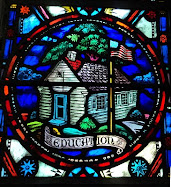by Virginia Knowles
Favorite Series Fiction
- American Girls series -- elementary level fiction about seven young ladies from different eras, such as Colonial Williamsburg, the Civil War, immigrant pioneers, etc. Each girl has six books which give a fascinating flavor of typical lifestyles. There are supplemental craft, cooking, and drama titles for each character, as well as the dolls, accessories and trading cards.
- The Little House books by Laura Ingalls Wilder -- the classics for a study on pioneers. Look for other spin-off books (cooking, crafts, etc.) and easy readers.
- The American Adventures series by multiple authors such as Norma Jean Lutz -- 48 novels, covering time period from 1620-1945 (these may be out-of-print but you can find them on-line or in used bookstores)
- Christian Heritage series by Nancy Rue -- novels covering Colonial period until World War II, for ages 8-12. (Bethany House / Focus on the Family)
- If You Lived... series published by Scholastic Books -- easy books which tell about daily life, especially for children, during various historical eras
- Meet George Washington and other Step-Up biographies (early elementary)
- Childhood of Famous Americans -- series of easy biographies covering the early lives of dozens of the greats. See related blog post by Cheryl Bastian.
- Pocahontas, George Washington, Abraham Lincoln, Benjamin Franklin and other books by Ingri and Edgar d’Aulaire -- highly illustrated, but lots of text
- Cornerstones of Freedom series -- focuses on key events and landmarks in American history, such as the California Gold Rush or the Statue of Liberty.
- Where Was Patrick Henry on the 29th of May?, George Washington’s Mother and other history books by Jean Fritz -- written with a tongue-in-cheek style
- The Thanksgiving Story and The Fourth of July Story by Alice Dalgliesh (early elementary)
- In God We Trust: Stories of Faith in American History by Timothy Crater and Ranelda Hunsicker (published by Chariot) -- short, readable biographies of American’s Christian leaders, all in one volume. This is a must have book!
- Samuel Eaton’s Day and Sarah Morton’s Day by Kate Waters (early colonial, picture books)
- Squanto, Friend of Pilgrims and A Lion to Guard Us (about Jamestown) by Clyde Robert Bulla -- early elementary
- The Courage of Sarah Noble by Alice Dalgliesh -- easy novel, early pioneer times in Pennsylvania
- A Picture Book of Paul Revere and other books by David Adler -- you should be able to find these in your public library
- The Cabin Faced West by Jean Fritz -- a sweet tale, based on a true story, about living in Western Pennsylvania in the 1700s (easy novel)
- The Blue and the Gray by Eve Bunting -- two modern friends, one black and one white, looking back on a Civil War battlefield (picture book)
- Growing Seasons by Elise Lee Splear, paintings by Ken Stark -- farm life around 1906 (picture book with lots of informative text)
- Benjamin West and His Cat Grimalkin by Marguerite Henry -- picture book story of the famous artist
- Lights on the River by Jane Resh Thomas (picture book about migrant workers)
- The Witch of Blackbird Pond by Elizabeth George Speare (Puritan era) See my free study guide here: http://continuewellhomeschool.blogspot.com/2009/08/witch-of-blackbird-pond-study-questions.html
- Johnny Tremain by Esther Forbes (Revolutionary War) See my free study guide here: http://continuewellhomeschool.blogspot.com/2009/08/johnny-tremain-study-guide-by-virginia.html
- Caddie Woodlawn by Carol Ryrie Brink (pioneer times)
- Across Five Aprils by Irene Hunt (Civil War)
- Turn Homeward, Hannalee and Be Ever Hopeful, Hannalee by Patricia Beatty (Civil War and Reconstruction as told from perspective of young displaced Southern girl
- Roll of Thunder, Hear My Cry by Mildred Taylor (racism in 1930s Mississippi -- part of a series)
- Words by Heart by Ouida Sebestyen -- another book about racism, and a young girl with Scripture tucked into her heart to help her through tragedy and forgiveness -- you can also get the DVD
- Rascal by Sterling North (the story of a raccoon and a boy in the early 1900s)
This list is a companion article to Weekly Grading and Lesson Planning. I'll try to update it as I think of other books, so check back!
Blessings,
Virginia Knowles
http://www.startwellhomeschool.blogspot.com/

















